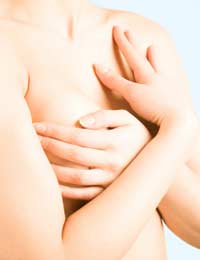What Are Breast Cysts?

The main thing to know about breast cysts is that they are usually completely harmless. Breast cysts are rarely connected with breast cancer and they do not develop into breast tumours. Each one is a small, fluid filled sac that develops in the breast; it can be felt during a breast self-examination, and it can appear on a mammogram.
Recognising a Breast Cyst
When you feel a lump in your breast it is natural to become very anxious. Most lumps turn out to be nothing to worry about, however, and some will be just breast cysts. When you feel a lump, a cyst will feel smooth and not hard; it can be squashed easily because it is full of fluid. Breast cancer tends to produce lumps that are very hard and do not move against the underlying tissue. Breast cysts may still be painful, however, as they can press on a nerve or a duct and cause inflammation within the breast. Breast pain is not necessarily a sign that you might have breast cancer either.In a mammogram, a breast cyst might be visible but it will look far less dense than a tumour, either a cancerous tumour or a benign tumour.
When a suspicious lump is found, it needs to be checked out and the two tests that can reveal if a lump is a breast cyst are ultrasound and a fine needle aspiration. Ultrasound can detect whether a lump is filled with fluid or whether it contains dense tissue and an aspiration can draw fluid out of the cyst for further testing. That it is possible to draw off fluid easily is usually fairly good evidence of a breast cyst.
Who is At Risk of Breast Cysts?
Younger women do not often develop breast cysts. They are most common in women just before the menopause – so aged between 35 and 50. Breast cysts are also a common feature in women who need to take hormone replacement therapy to prevent uncomfortable symptoms during the perimenopause and menopause. These can include hot sweats, mood swings and heart palpitations.Why do Breast Cysts Form?
A breast cyst is simply an accumulation of excess fluid in the breast and this can occur for many different reasons. The most common is the action of hormones. In a woman taking hormone replacement therapy, the excess of oestrogen in her system can stimulate the breast to release more fluid into the tissues than can be absorbed. This excess fluid collects in small pockets, bounded by tissue, and a cyst appears.In women who are still having monthly periods, breast cysts are more common during the few days before a period, as the changes in hormones often lead to fluid retention generally, and specifically in the breast tissue.
Recurrent Breast Cysts
Sometimes, even after a cyst has been drained by a fine needle aspiration, it will come back, sometimes several times after the treatment has been done. This doesn’t mean that the cyst is becoming cancerous – it is just the change in the tissue that has become permanent over time. The best treatment is a small operation that involves little more than a breast biopsy, to remove the affected tissue so that fluid does not keep building up in the same place. If you are prone to breast cysts, this will not prevent them forming elsewhere in the breast.Business Energy With a Difference
If you are looking for business energy or need advanced solutions like remote energy monitoring, new supplies, downgrading or upgrading capacity, have a no obligation chat with Purely Energy.
To find our more get in touch here. or call 0161 521 3400.








